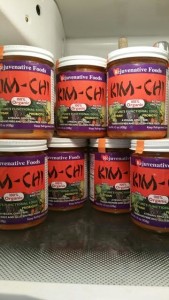KOREAN KIMCHI RECIPE
Ingredients
2 heads of Napa cabbage (or another Chinese cabbage variety), shredded in a food processor
5-10 scallions or spring onions (similar to scallions, only stronger and hotter in flavor), finely chopped
2-3 cloves garlic, crushed
1 teaspoon crushed, fresh ginger or powdered ginger
2 jalapeños, minced fine
2 tablespoons crushed fresh red chili pepper
Half an onion (optional)
Culture Starter
2 tablespoons of honey or 1-3 scoops of EcoBloom as food for the microflora (see below)
Combine all ingredients in a large bowl.
Remove several cups of this mixture and put into a blender.
Add enough filtered water with the mixture in your blender to make a “brine” the consistency of a thick juice. Blend well and then add brine back into first mixture. Stir well.
Pack mixture down into a 1½ quart glass or stainless steel container. Use your fist, a wooden dowel, or a potato masher to pack veggies tightly.
Fill container almost full, but leave about 2 inches of room at the top for veggies to expand.
Roll up several cabbage leaves into a tight “log” and place them on top to fill the remaining 2 inch space. Clamp jar closed or screw on air tight lid.
Let veggies sit at about a 70-degree room temperature for at least three days. A week is even better. Refrigerate to slow down fermentation. Enjoy!
With this delicious and nutritious food on the menu, it’s no wonder that Koreans, who traditionally eat a diet based on vegetables, grains, and fermented foods, are some of the healthiest people on the planet.
Koreans do eat small amounts of protein including meat and seafood, but their consumption of fermented kimchi is what sets their diet apart.
Traditional kimchi is made from cabbage, garlic, red pepper, and salt. Some people like to add other flavors, using scallions or ginger. Another option is to include shredded apple for a touch of sweetness.
Regardless of ingredients, the vegetables are chopped into bite-sized pieces or are shredded. They are then mixed together with seasonings and fermented (in the olden days they were buried underground in earthenware pots, where they fermented at a constant 55-degree temperature.)
The result is a nutrient-dense superfood that is healthier than almost anything else you can possibly eat.
Read more about kimchi in The Body Ecology Diet: Recovering Your Health and Rebuilding Your Immunity by Donna Gates

